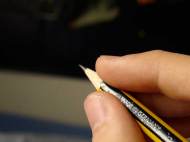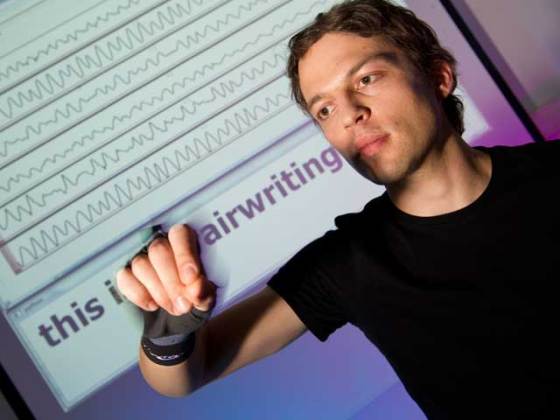Airwriting input device enables 3D writing in air
 Computer scientists at Karlsruhe Institute of Technology (KIT) developed a technology which enables “airwriting” – a technology which might change the way we input data while on the go while by writing data in air. Since it can be worn like clothes, which can be integrated seamlessly into the everyday life of the user, the system could be used for a wide variety of wearable computing applications.
Computer scientists at Karlsruhe Institute of Technology (KIT) developed a technology which enables “airwriting” – a technology which might change the way we input data while on the go while by writing data in air. Since it can be worn like clothes, which can be integrated seamlessly into the everyday life of the user, the system could be used for a wide variety of wearable computing applications.
“Information technology is used any time and anywhere, but smart phones are still working on the basis of virtual keyboards and small screens. However, gestures allow for new types of input – in particular for mobile devices or devices integrated in clothing. The interaction is embedded seamlessly in everyday life”, said Christoph Amma, doctoral student who developed the system at KIT’s Cognitive Systems Lab (CSL). “The airwriting glove is used to write letters into air, as if using an invisible board or pad.”
Instead relying on visual data or sound as some information interaction approaches we previously described, airwriting relies on acceleration sensors and gyroscopes are attached to the thin glove. They record the movements of the hand and transmit them to a computer system via a wireless connection. Interesting part is that the folks involved in its development decided to device a way for the system to check whether the user is indeed writing instead simply relying on turning airwriting mode on or off.
“All movements that are not similar to writing, such as cooking, doing laundry, waving to someone, are ignored. The system runs in the background without interpreting every movement as computer input”, said Amma.
So, how does the system work? During writing, the airwriting system decodes the letters by a pattern recognition method. For every letter of the alphabet, a statistical model of the characteristic signal pattern is stored. It also takes into account individual differences in the writing style. This means that after a bit of use by a user, the system becomes more precise. The system can recognize complete sentences written in capital letters and it has a vocabulary of 8,000 words at the moment.
The system isn’t perfect yet, since it has an error rate of 11 percent. Its precision is better when the airwriting adapts to the individual writing style of the user when the error rate drops to three percent. Google awarded Amma and his mentor Professor Tanja Schultz, with “Google Faculty Research Award”. Combined with the possibility to input commands and texts by gestures, the system is well suited for future mixed-reality applications.
KIT CSL researchers are now working on further refining the method to filter out writing. Moreover, they want to make the system smaller in order to increase wearing comfort and user acceptance.










Innovative.
Dr.A.Jagadeesh Nellore(AP),India
what are advantages of using this.can u show any ppt slides giving a brief view about air writing technology